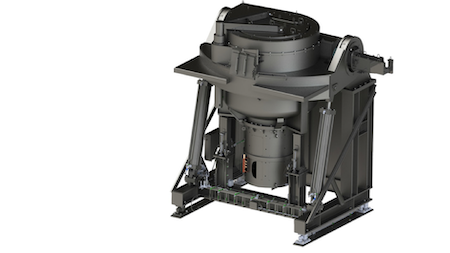Source: Inductotherm.com
Casting consumer markets like the aerospace industry require tight specifications and tolerances for the aluminum components they purchase. Aluminum foundries and diecasting operations need to be able to meet these specifications by producing high-quality aluminum products in a variety of alloys. Therefore, alloy flexibility is critical to being able to serve these markets, a parameter that is not easily accomplished with conventional, large-volume gas-fired aluminum melting furnaces.
Inductotherm Corp. manufactures advanced furnace technologies for aluminum and other metals, including both coreless and channel metal holding furnaces, each providing unique advantages:
• Coreless furnaces provide maximum alloy flexibility with significantly lower capital and installation costs.
• Channel furnaces are capable of holding large quantities of metal at low holding power levels for extended periods of time for economical high-volume production.
Now, Inductotherm is offering a Hybrid Furnace that draws on advantages from both designs for aluminum melting, holding, and casting operations. This new furnace is designed to enable operational flexibility, allow for inert gas cover, and offer quick alloy changes—making it attractive for a variety of aluminum casting applications.
The coreless inductor with super heating capability is the heat source for the melting and holding operations. The furnace is operated using a solid-state power supply with a Melt-Manager® Plus™ control system to control the melt process. The power supply is designed to meet the most optimal frequency for the application. The use of a coreless inductor allows the Hybrid Furnace to be fully emptied after the melting and casting operation has taken place, as opposed to a channel inductor, which requires that a metal heel be maintained at all times with a constant energy supply to keep the metal molten. This allows for alloy flexibility, because a new alloy mix can be added after the furnace has been emptied.
The coreless inductor is mounted onto the bottom of the upper case of the Hybrid Furnace. The rugged upper case (which is based on the channel furnace design) ensures high strength, integrity, and refractory life. It incorporates a lift and swing lid that provides access to the furnace hearth for charging material such as sows and ingots in a variety of sizes.
The case’s thick refractory lining ensures minimum temperature loss and allows for thermocouples to be embedded for continuous temperature measurement. Combined with a temperature control system, the thermocouples provide precise control during the entire holding and pouring process to keep the aluminum in the desired temperature range.
The Hybrid Furnace is available in standard sizes (10-40 metric tons) and also can be adapted to larger applications. It is mounted in a rugged stanchion together with hydraulic cylinders for dependable tilting performance. Incorporated into the design are a set of load cells that indicate the weight of the metal, a variety of fume exhaust devices that ensure a clean work environment, and a dross door together with a back tilting system that allows for dross removal from the melt surface.
Metal dispensing for the Hybrid Furnace is available either as a trunnion pour or a siphon arrangement, similar to channel furnaces. The siphon pour spout draws the metal from below the metal surface. A PLC system controls all aspects of the tilting and pouring process, allowing for controlled metal flow from the furnace into the launder and then to the caster.
Source: Inductotherm.com


